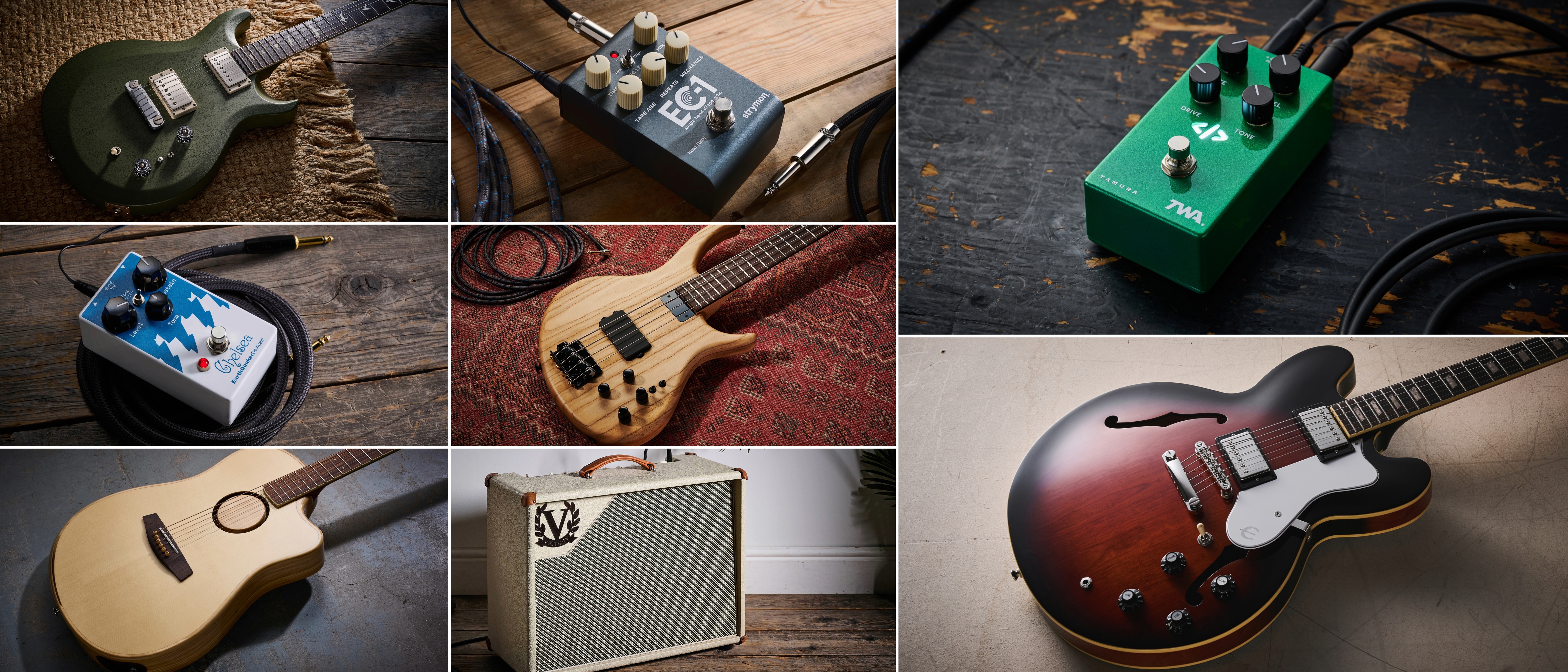His playing blew the minds of Yngwie Malmsteen, Steve Vai and Eddie Van Halen, while his improvisation was up there with John Coltrane and Charlie Parker – here’s how Allan Holdsworth reinvented the way we approach the electric guitar
This in-depth masterclass in the fusion icon’s virtuoso style is for moderate to advanced players ready to level up their legato chops, outside playing and minor chord vocabulary

In the evolution of fusion guitar, Allan Holdsworth’s contribution can only be compared to that of Jimi Hendrix’s role in the foundation of rock guitar, and Django Reinhardt’s in the development of the instrument in the jazz world.
Holdsworth essentially reinvented the instrument through numerous aspects of his approach: through his fretboard concept which involved seeing every available note across the guitar neck at a glance, free of positions and fingering but also, crucially, in his harmonic concepts.
Finally, Holdsworth is probably most famous for his ferociously fast execution of lines using, as he did almost exclusively, a legato playing approach.
Holdsworth pushed the complexity of jazz harmony as far as anyone in the history of the music. He was also pioneering in terms of his sound, using high-gain amps and modulation and delay. Holdsworth’s tone has both saxophone and violin-like elements, while his clean chord sound had a keyboard-like timbre.
Ultimately, his originality as a composer and performer puts him in the elite of guitarists; as a jazz improviser he is surely in the top tier of masters alongside John Coltrane, Charlie Parker, Keith Jarrett and Herbie Hancock.
In the 1980s, Allan was championed by leading rock and metal players such as Yngwie Malmsteen, Steve Vai, and Eddie Van Halen, on whose playing style he clearly had a huge influence. Holdsworth continued to release highly innovative fusion albums, refining and evolving in both his incredible fretboard mastery and his command of tone.
Holdsworth’s death in 2017 was a major shock to the music world. Respect and admiration for his music has increased through new audiences discovering his contribution to music via the internet.
All the latest guitar news, interviews, lessons, reviews, deals and more, direct to your inbox!
To some extent, Holdsworth’s style is so highly evolved and complex that it defies being boiled down to ‘signature licks’ or ideas. However, as with the other players covered in this series, there are some recognisable motifs, melodic cells and stylistic features that we might extract or identify as ‘Holdsworthian’.
At this point, we must acknowledge Holdsworth’s mastery of legato: a very strong legato technique is essential to execute the following lines cleanly at speed.
It’s outside the scope of this article to give a detailed analysis of legato playing, but the best advice for those new to the technique would be to aim for equal clarity of articulation whether a note is struck with the plectrum, or executed with a hammer-on or pull-off. Holdsworth said this was one of his greatest priorities.
A very ‘square on’ hand and fingering position is also crucial, with the thumb placed in the middle of the back of the neck, pointing upwards to form a 90-degree angle to the neck itself, so as to allow the greatest reach for the fingers.
Get the tone
Amp Settings: Gain 9, Bass 7, Middle 7, Treble 4, Reverb 3
The examples were recorded using a semi-hollow PRS guitar’s bridge humbucker with the tone control rolled down to for a smooth, even sound. The recording was made using a Line 6 Helix set to model of a Marshall amp with plenty of gain. Go for a fat, smooth, high-gain tone with the treble pot rolled about halfway back, then add some light reverb and delay.
Example 1
This line contains two three-note motifs that Holdsworth frequently uses in many different harmonic settings. This can be analysed in a number of ways but it is probably most straightforward to see it as a diminished scale fragment, with the Root, b3 and Major 3rd present.
These melodic cells can, in turn, be moved around in major 3rds or in b5ths, as well as combined with different rhythmic combinations of the three intervals. The notes are played first as 16ths then 8ths.
Example 2
This shows how Holdsworth embellishes target or chord tones. If we take the last note D as the intended ‘target’ and see the line in the context of an underlying G minor tonality, we may view this as Allan’s four-note version of the classic ‘semitone-below-chord-tone-above’ embellishment. Again, 16ths are played first then 8ths.
Example 3
This line hints at Holdsworth’s use of bi-tonality or polytonality: that is, he uses two or more tonalities simultaneously or alternately within a bar to build harmonic density over a given root note or tonic.
Here, the key centre is G minor, starting with a three-note D minor pentatonic idea. The example then uses the three-note motif from example Ex1, built from an Eb but played descending by starting on the ‘upper note’ G followed by the Gb (F#) at the 14th fret.
Example 4
Our final melodic cell takes Example 1’s structure and moves it in b5ths, in groupings of five. The texture is very ‘Holdsworthian’ and should suggest, to both the ears and fingers, a world of possibilities. To help, the later repetitions are played slower with the notes being 8ths.
Example 5
This idea moves through all 12 keys using a simple root-3-2-root (C-E-D-C) idea starting in C major. The concept behind the line is that, as fingers ascend the fretboard we descend another semitone each time.
However, a single-cutaway guitar or one with a wide neck might make this difficult so here, when the lick reaches the fifth string, it starts to descend once the key of Db is reached.
Harmonically, all of this amounts to an extended exercise in tension and release as we pass through the 12 keys with varying amounts of consonance and dissonance, depending on the notes within our three-note cell.
Example 6
This idea starts with G diminished (half-whole) idea at the 10th fret but then shifts to G whole-half at the 8th. Half-way through bar 2, the lick uses the five-note enclosure concept to target the 3rd of G minor (Bb on the second string at the 11th fret), G on the third string (12th fret) and D on the fourth string (12th fret).
Eventually the lick reaches the sixth string and here we play a simple G minor melodic idea to end the line. Remember, 16ths first (as shown) then 8ths.
Example 7
This example begins with an enclosure of the b6 (Eb). That is, the target note is enclosed or surrounded by an upper and lower ‘neighbour’ note. A five-note enclosure is then played five times moving in b5ths starting on the fifth string and landing on the target notes A (the 9th) and Eb (the b6) of G minor respectively.
Eddie Van Halen appropriated these types of symmetrical ideas and you can hear them are all over Van Halen’s 1984 album.
Example 8
This lick starts by using a simple and familiar pentatonic motif but quickly takes a left turn into some extreme dissonance using G whole-half and G diminished (half-whole) scales and even a fragment of G whole-tone, resolving more comfortably to G Dorian in the second bar.
Example 9
In contrast to the previous line, this idea presents an example of a diatonic line over a major chord. Holdsworth’s playing can be surprisingly diatonic and the line contains only notes from G Dorian.
Notice the typical three-notes-per-string scale type fingerings and the string skip from the third string to the first. The ending is a representation of Holdsworth’s melodic and lyrical side, using space in contrast to a dense streams of notes.
Example 10
This idea takes a melodic cell, the formula for which is Root-b2-3rd, and this fragment is moved around in parallel, so the first note changes but the other two retain the same intervallic relationship with it.
Notice how the same note is played on different strings for an overlapping or doubling effect. Notice too how the lower note from each three-note grouping, either A, F or C#, spells out an augmented chord.
Example 11
Our final example takes the same 1-b2-3 cell but moves in an ascending direction. This time though, the cell is played twice on each string with a gap of a semitone between each iteration of it.
Again, the first note of each eight-note grouping is a major 3rd away from the previous one and once again implies an augmented sound. From another perspective, the line contains all 12 tones organised from four augmented triads: Ab-A-Bb-B but using one three-note cell.
